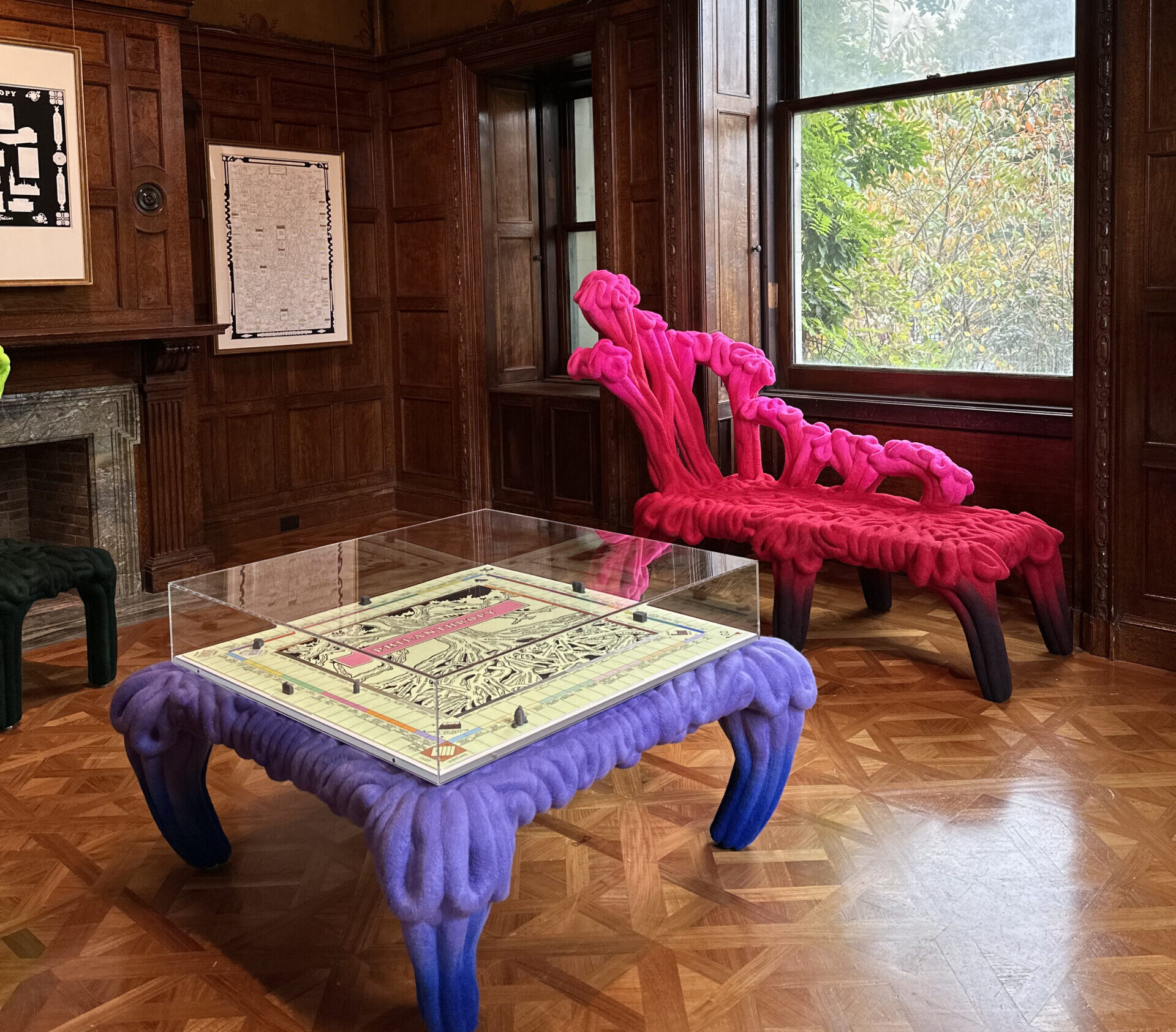GAME ROOM

ABOUT THE INSTALLATION
LIAM LEE
BORN 1993, NEW YORK, NEW YORK; ACTIVE BROOKLYN, NEW YORK
TOMMY MISHIMA
BORN 1980, LIMA, PERU; ACTIVE BRONX, NEW YORK
With inventiveness and wit, designer Liam Lee and artist Tommy Mishima critically examine Andrew Carnegie’s rise to power, networks of access, and philanthropic strategies. Carnegie built his fortune in the steel industry, becoming one of the richest men in the world and a leading philanthropist in the United States. He profoundly influenced the fields of science, education, finance, and international relations through monetary support via his four major giving arms: Carnegie Institution of Washington, Carnegie Endowment for International Peace, Carnegie Corporation of New York, and Carnegie Foundation for the Advancement of Teaching.
Placed in Carnegie’s original home office, where he made his charitable decisions, Mishima’s drawings dive into the philanthropist’s formidable legacy by mapping the far-reaching ways his money is still at play today. The objective of Mishima’s game Philanthropy—a handmade board game inspired by Monopoly—is to become the most powerful agent through tactical grant making, fundraising, and selling access to institutional research. In tandem, Lee created a series of furniture pieces inspired by Carnegie’s original office design. Each piece, carefully crafted with hand-dyed felted wool, references the mycelium networks that facilitate the distribution of nutrients to plants and power the growth of the forest—an apt metaphor for the systems of power that Carnegie cultivated throughout his life.
Visual description: Gallery
In a small enclave, we find ourselves in Andrew Carnegie’s former private study just off of the Carnegie Library. The historic architecture features wood panels that line the walls; a golden mural bordering the top of the wall paneling depicts lilies and scrolls. A stretch of scroll above the mantel reads, “The kingdom of Heaven is within you.”
The small space is furnished with four brightly colored felt furniture pieces; a large lavender colored table, a small lime green chair, a magenta chaise, and a moss green partition. Each of these installation objects are rounded and organic in shape and form. The texture on the table, chair, and chaise are bumpy and ridged due to the felting technique executed by the designer. This is because each piece appears as if it is made of winding ropes or large squiggly worms packed closely together. Both the seat back of the chair and the chaise are made of clusters of strands stretching upwards, vertically; resembling ombre colored coral.
Placed on the lavender-colored coffee table is a board game, resembling Monopoly, in a plexiglass case. In the center of the gameboard is a black and white illustration of a tree. Its intertwined roots are labelled with different fields of study including astronomy, economics, sociology, and mathematics. The roots come together to create the trunk of the tree where the name of the game is printed in a bubblegum pink text box that reads the title of the game, “Philanthropy.” The illustration is framed with two rows of boxes labelled with various prestigious institutions such as Tufts University, American Museum of Natural History, and the Institute of Economics.
On the walls are a series of four drawings, each depicting complex charts illustrating Andrew Carnegie’s four major giving arms: Carnegie Institution of Washington, Carnegie Endowment for International Peace, Carnegie Corporation of New York, and Carnegie Foundation for the Advancement of Teaching. The charts illustrate Carnegie’s vast influence as countless arrows connect dozens of names and institutions. For example, the name “Henry S Pritchett” has an arrow pointing to “William G. Rockefeller” with another arrow leading to “Woodrow Wilson” before connecting the names to “Princeton University.” A detailed and intricate webbed map illustrates systems of power and influence. The institutions included on the prints can also be found organized on the “Philanthropy” board game.
Above the mantle is a black-and-white print with the word “philanthropy” printed at the top of the page and the silhouettes of grand buildings placed underneath.